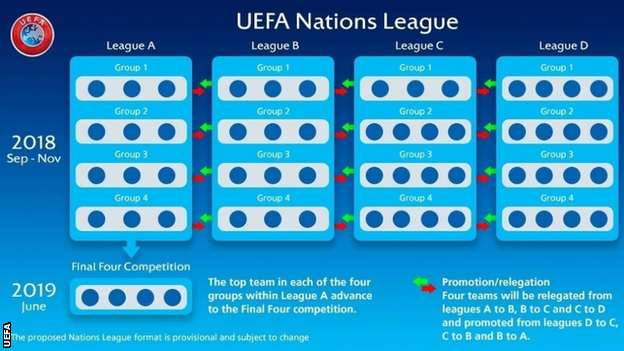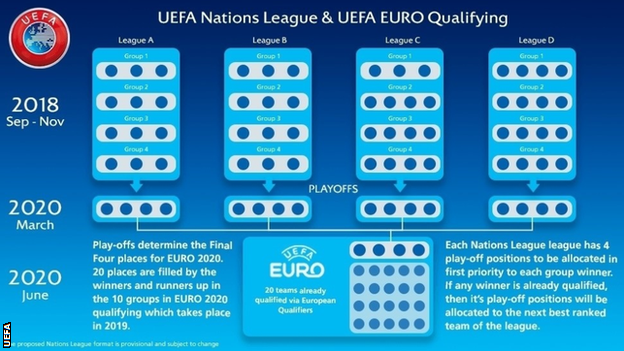Nations League: Wales beaten to spot in league A by Netherlands
- Published
- comments

Wales lost 1-0 to Republic of Ireland on Monday
Wales have missed out on a place in the top tier of Uefa's new Nations League tournament after losing their final World Cup qualifier.
The Nations League sees the 55 European national teams divided into four pots dependent on their rankings, with the top 12 going into League A.
The Republic of Ireland, who beat Wales to get into the World Cup play-off, are also in League B with Northern Ireland.
England are in League A with Scotland in League C.
Netherlands' 2-0 win over Sweden in their final game in World Cup qualifying Group D took them above Wales, into 12th place in Uefa's coefficient rankings, to claim the final place in League A.
But what is the Nations League? How does it work? And what's the point of it?
Uefa say it "creates more meaningful and competitive matches for teams and a dedicated calendar and structure for national team football".
The competition, which starts in September 2018, will provide four qualifying spots for Euro 2020 and will determine the composition of the draw pots for the subsequent Euro 2020 qualifiers.
By virtue of the format, lower-tier countries - the bottom 16 in the rankings - are now guaranteed one of the 24 qualifying slots for the European Championship finals.
There will also be promotion and relegation between divisions.
Each of the four tiers A, B, C and D will contain four groups of three or four teams, with these decided in a draw on Wednesday, 24 January 2018 in Lausanne, Switzerland.
Uefa Nations League composition | |||
|---|---|---|---|
League A | League B | League C | League D |
Germany | Austria | Hungary | Azerbaijan |
Portugal | Wales | Romania | Macedonia |
Belgium | Russia | Scotland | Belarus |
Spain | Slovakia | Slovenia | Georgia |
France | Sweden | Greece | Armenia |
England | Ukraine | Serbia | Latvia |
Switzerland | Republic of Ireland | Albania | Faroe Islands |
Italy | Bosnia and Herzegovina | Norway | Luxembourg |
Poland | Northern Ireland | Montenegro | Kazakhstan |
Iceland | Denmark | Israel | Moldova |
Croatia | Czech Republic | Bulgaria | Liechtenstein |
Netherlands | Turkey | Finland | Malta |
Cyprus | Andorra | ||
Estonia | Kosovo | ||
Lithuania | San Marino | ||
Gibraltar | |||
The format of the Nations League
The 55 European national teams have been divided into four leagues based on Uefa's national association coefficient rankings on 11 October, 2017.
Leagues A and B, the top two divisions, will consist of four groups of three teams.
League C will comprise one group of three teams and three groups of four sides, while League D will be made up of four groups of four teams.
The draw for the first phase Nations League will take place in Lausanne, Switzerland, on 24 January, 2018.
In each league, four group winners are promoted (or play in the Nations League Finals, see below) and four teams are relegated for the next competition to be played in 2020.
The overall Nations League rankings will determine the composition of the draw pots for the subsequent European qualifiers (European Championship or World Cup).
The Nations League will also provide four teams which will contest play-offs in March 2020 (see below) to qualify for Euro 2020.

When will the Nations League take place?
The Nations League group games will be held over six matchdays, during the 'double-headers' in September, October and November 2018.
The winners of the four groups in League A will contest the Nations League Finals competition in June 2019.
The knockout Nations League Finals (semi-finals, third-place match and final) will be hosted by one of the four countries, appointed by the Uefa Executive Committee in December 2018.
How will the Nations League affect qualifiers?
The top two in each of the 10 qualifying groups for Euro 2020 will qualify automatically. There will be five groups of five teams and five groups of six teams.
The remaining four of the 24 places for Euro 2020 will go to play-off winners, comprised of the 16 group winners of the Nations League.

The Euro 2020 qualifying draw will be made after the completion of the UEFA Nations League and allow for the four UEFA Nations League Finals participants to be drawn into groups of five teams.
The Euro 2020 qualifiers start in March 2019. There will be two matchdays in each of March, June, September, October and November 2019.
If a group winner has already qualified via the European qualifiers, then their spot will go to the next best-ranked team in their league.
If a league does not have four teams to compete, the remaining slots are allocated to teams from another league, according to the overall Uefa Nations League ranking.
Each league will have a path of its own and each path will feature two single-leg semi-finals and one single-leg final. The winner of each path will win a place at Euro 2020.
UEFA Nations League calendar
Group stage draw: 24 January 2018
Matchday 1: 6-8 September 2018
Matchday 2: 9-11 September 2018
Matchday 3: 11-13 October 2018
Matchday 4: 14-16 October 2018
Matchday 5: 15-17 November 2018
Matchday 6: 18-20 November 2018
Finals draw: early December 2018
Finals: 5-9 June 2019
Euro 2020 play-off draw: 22 November 2019
Euro 2020 play-offs: 26-31 March 2020